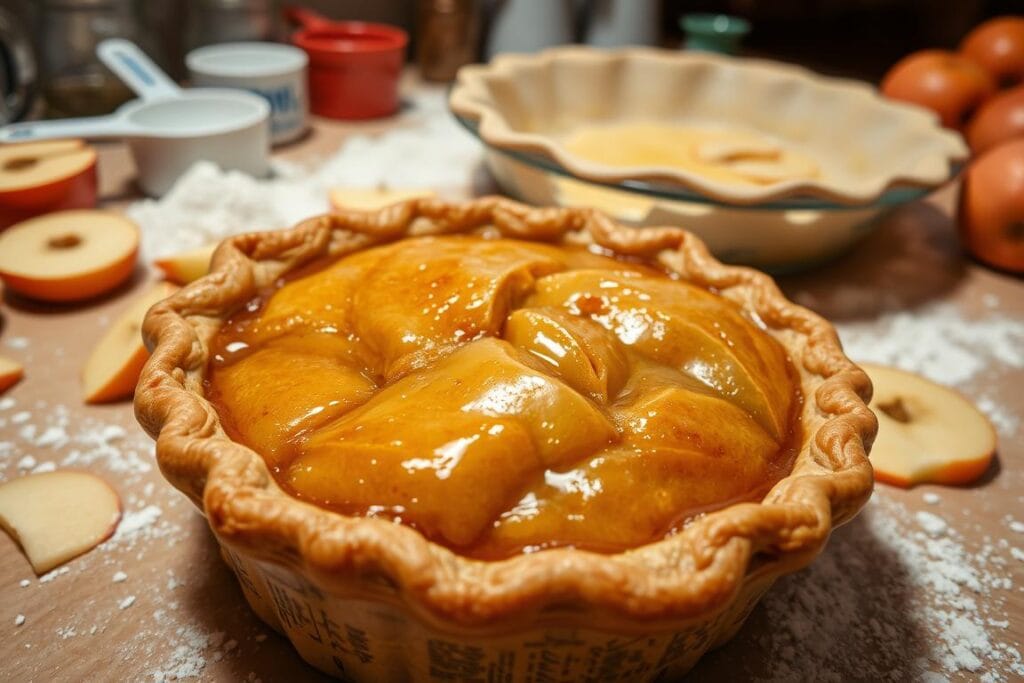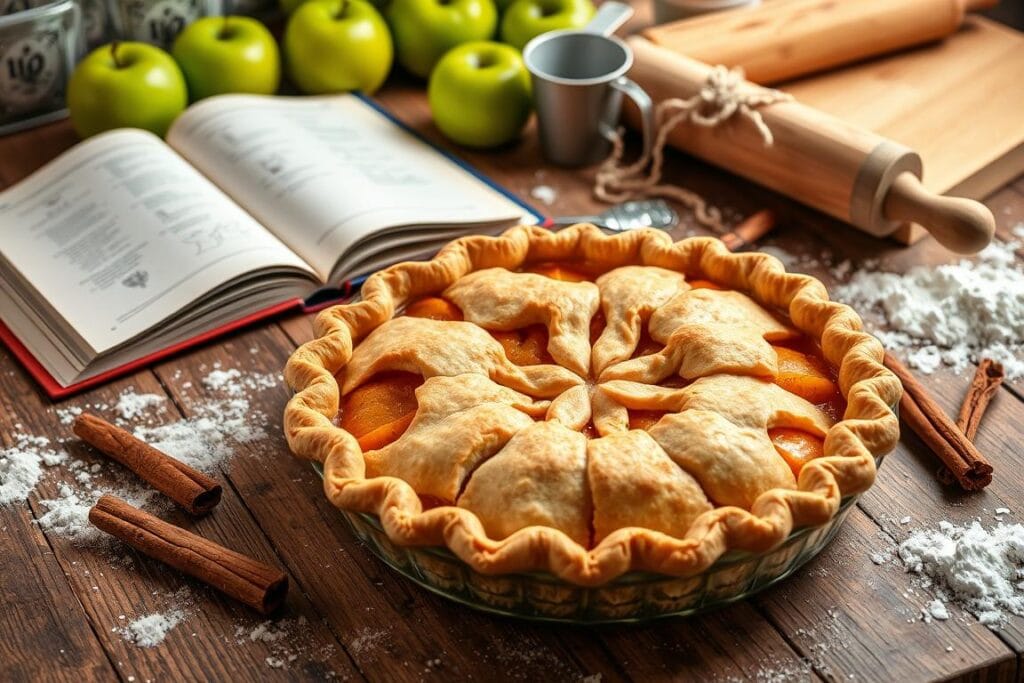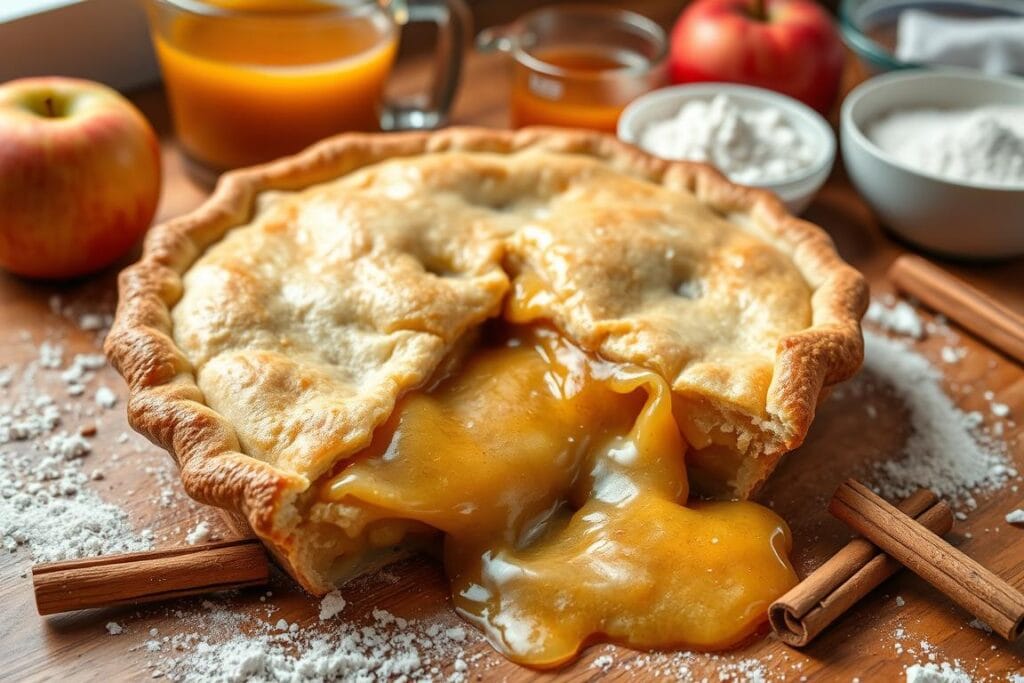
Every time I pull my apple pie out of the oven, I’m met with disappointment. The beautiful golden crust promises perfection, but the moment I slice into it, a pool of liquid floods the plate. Sound familiar? The frustration of a watery apple pie can turn even the most passionate home baker into a kitchen skeptic.
Crafting the perfect origami apple pie before fold requires more than just throwing ingredients together. A truly remarkable pie demands precision, understanding, and a few strategic techniques to transform that runny filling into a luscious, thick masterpiece.
In this guide, we’ll dive deep into the science behind watery apple pies. We’ll uncover the secrets to creating a perfect pie filling. This will make your family and friends beg for seconds.
Key Takeaways
- Understand the moisture content of different apple varieties
- Learn critical thickening agent techniques
- Master pre-baking and baking strategies
- Discover how to control pie filling consistency
- Prevent common mistakes that lead to watery pies
Understanding the Science Behind Watery Apple Pies
Exploring baking tutorials can really improve your cooking skills. Knowing the science behind apple pie is key. It helps you understand how different elements work together when baking.

Choosing the right apple is essential for a moist pie. Each apple type has its own chemical makeup. This affects the pie’s texture.
The Role of Moisture in Apple Varieties
Picking the right apple is vital to avoid a soggy pie. Some apples are better for pie-making than others. Here’s why:
- Granny Smith: Low moisture, keeps its shape
- Honeycrisp: Moderate moisture, has a balanced feel
- Fuji: High juice, needs careful handling
Chemical Reactions During Baking
Baking starts a chain of chemical changes. Sugars, starches, and pectin mix to shape your pie’s texture. Folding techniques and controlling the temperature are important for these reactions.
Impact of Temperature on Filling Consistency
“Temperature is the silent conductor of your pie’s symphony.” – Professional Pastry Chef
Your oven’s heat is what makes the pie filling thick and perfect. Heat above 140°F is key for the right texture.
By understanding these scientific basics, you’ll make pies that are tasty and well-made. You’ll impress everyone with your cooking skills.
For additional tips, check out this Wikipedia guide on why apple pies become watery.
Common Causes of Runny Apple Pie Filling
Creating the perfect dessert recipes requires understanding why your apple pie might turn out watery. Several key factors can transform your baking dreams into a soggy nightmare.

Your apple pie’s filling consistency depends on multiple culinary variables. Let’s explore the primary reasons behind those frustrating liquid-filled pies:
- Moisture-heavy apple varieties
- Inadequate thickening agents
- Insufficient baking time
- Improper ventilation techniques
Baking hacks reveal that different apple types dramatically impact your pie’s texture. Juicy apples like Gala or Golden Delicious contain more water content, which can lead to runnier fillings.
| Apple Variety | Water Content | Pie Consistency Risk |
|---|---|---|
| Granny Smith | Low | Low Risk |
| Honeycrisp | Medium | Moderate Risk |
| Red Delicious | High | High Risk |
“The secret to a perfect pie is understanding your ingredients’ unique characteristics.” – Professional Baker
Premature cutting can also compromise your pie’s structure. Slicing a hot pie causes the filling to collapse, creating a watery mess. Wait until the pie has cooled completely to ensure a firm, delectable slice.
Professional bakers recommend experimenting with thickening agents and selecting the right apple varieties to achieve that perfect, non-runny filling in your dessert recipes.
Essential Thickening Agents for Apple Pie
Making the perfect apple pie is all about getting the filling right. Thickening agents are key to turning a sloppy mess into a masterpiece of taste and texture.
The right thickener can make your pie’s texture pop. Each agent has its own way of absorbing fruit juices, making the filling smooth and perfect.
For step-by-step instructions on using these ingredients, check out this related recipe on Alex’s Recipes.
Comparing Thickening Powerhouses
Not all thickeners are the same. Here are the top ones:
- Cornstarch: Quick-acting and translucent
- Flour: Traditional and easy to find
- Tapioca: Gives a glossy, clear filling
Precise Thickener Ratios
| Thickener | Amount per Cup of Fruit | Best For |
|---|---|---|
| Cornstarch | 1-2 teaspoons | Fresh, juicy fruits |
| Flour | 2-3 teaspoons | Traditional pies |
| Tapioca | 1-3 teaspoons | Achieving glossy finish |
Timing Your Thickener Addition
Mix your thickener with sugar and spices before adding to the fruit. This helps it mix evenly and avoids clumps. For Fuji or Honeycrisp apples, you might need a bit more thickener because they’re juicier.
“The secret to a perfect pie is in the details of your thickening technique.” – Pie Masters Cookbook
Learning these thickening tips will take your pie from good to amazing. You’ll create a dessert that looks great and tastes even better.
Origami Apple Pie Before Fold: Preparation Techniques
Making a perfect apple pie is like a precise art, similar to paper crafts. The origami apple pie before fold method adds a scientific touch to baking. It makes your kitchen projects more precise.
When preparing your pie filling, be very careful. Drain the apple slices well in a colander to remove extra moisture. This step is key to avoiding a soggy crust and getting the right texture.
- Select firm apple varieties like Granny Smith or Honeycrisp
- Slice apples uniformly for consistent cooking
- Pat apple slices dry with clean kitchen towels
To achieve a great pie, pre-cook your filling. Cook the apple slices with sugar and spices on the stovetop. This reduces liquid and boosts flavors. It’s like the careful folding in origami paper crafts.
“Baking is an art, and every pie tells a story of careful preparation.” – Professional Baker’s Wisdom
Chilling your pie crust dough is also very important. Keep it cold until you’re ready to put it together. This keeps the butter from melting, which helps the crust stay flaky.
| Preparation Step | Key Detail |
|---|---|
| Apple Slicing | Uniform 1/4 inch thickness |
| Moisture Removal | Drain in colander, pat dry |
| Crust Preparation | Chill dough for 30 minutes |
Learning the origami apple pie before fold technique can turn you into a skilled baker. It’s all about practice, patience, and precision. These are the keys to baking a perfect pie.
Pre-Baking Strategies to Prevent Watery Filling
Making the perfect apple pie is more than just mixing ingredients. You need to prepare carefully to avoid a watery filling. Baking experts say using the right pre-baking methods is key to a thick, tasty pie.
Macerating Apples for Moisture Control
Macerating your apples is a top tip in baking. This method involves:
- Slicing apples and mixing them with sugar
- Letting the mix sit for 30-45 minutes
- Draining off extra liquid before filling the pie
This step helps remove moisture, making your pie filling less likely to be runny. Pro tip: Save the drained liquid for making a delicious apple syrup!
Ventilation and Steam Escape
Designing your crust right is also key. When making your pie, think about these ventilation tips:
- Make a lattice-style top crust
- Carve deep vents in a solid crust
- Use decorative cut-outs for steam to escape
Temperature Control Methods
“The secret to a perfect pie is all in the temperature control” – Professional Pastry Chef
Managing temperature is vital in baking. Chill your pie for 15 minutes before baking to set the filling. For baking at high altitudes, raise the oven temperature by 15-25°F and bake longer to adjust for lower boiling points.
Critical Baking Temperature and Time Guidelines
Mastering the art of baking temperature is key to making the perfect apple pie. Your oven’s heat is vital in turning raw ingredients into a tasty dessert. It ensures the filling is just right.
Experts suggest specific temperature ranges for the best results:
- Preheat your oven to 425°F-450°F
- Position rack in the lower third of the oven
- Use an oven thermometer for precise temperature reading
“Temperature is the secret weapon in creating a pie that’s both visually stunning and deliciously consistent.” – Professional Pastry Chef
For bakers at high altitudes, you’ll need to make some adjustments. Increase both the baking time and temperature by 25 degrees. This helps with the lower air pressure. Keep an eye on your pie – a golden-brown crust means it’s done right.
Pro tip: If your crust browns too fast, use aluminum foil to protect it. This keeps the crust from burning while the filling cooks well.
| Oven Temperature | Baking Duration | Expected Result |
|---|---|---|
| 425°F | 45-55 minutes | Golden crust, bubbling filling |
| 450°F | 35-45 minutes | Crisp crust, well-set filling |
Remember, patience and precision are your best allies in creating a perfect pie. It shows off your culinary arts skills.
Cooling and Setting Techniques for Perfect Slices
Making beautiful desserts is more than just baking. The cooling process is key to turning your apple pie into a masterpiece. It ensures your slices look perfect.
Learning to cool your pie right can make it go from good to great. Professional bakers know that patience is essential for making delicious desserts.
To ensure your pie doesn’t dry out or over-bake, refer to these baking hacks.
Room Temperature vs. Refrigeration
Cooling your pie needs careful planning. Room temperature is best for setting the filling. Here are some tips:
- Let the pie cool on a wire rack
- Don’t put it in the fridge right away
- Keep the room temperature steady
Optimal Cooling Duration
The right cooling time can turn your dessert into art. Here are some guidelines:
| Cooling Method | Duration | Result |
|---|---|---|
| Room Temperature | 3-4 hours | Ideal Filling Consistency |
| Overnight Cooling | 8-12 hours | Perfect Slice Formation |
Signs of Properly Set Filling
Your pie’s filling should show certain signs of being ready. Look for these visual and textural cues:
- Firm, not liquid filling
- Minimal jiggling when gently shaken
- Clean, neat slice edges
“Patience transforms a good pie into an exceptional culinary experience.” – Pastry Chef Expert
Troubleshooting and Fixing a Watery Pie After Baking
Discovering a watery apple pie can be frustrating. But, don’t worry! These baking hacks will help you save your dessert. You’ll impress your guests with quick DIY projects in the kitchen.
When your pie filling looks like soup, you have several rescue strategies:
- High-Temperature Rescue Method
- Stovetop Reduction Technique
- Quick Freezer Fix
- Creative Dessert Transformation
To fix it with high temperature, bake your pie at 425°F to 450°F. Bake for about 12 minutes to evaporate excess moisture. This works best for slightly runny pies.
Pro Tip: Always use a baking sheet to catch any drips and protect your oven floor.
If the filling is hard to fix, try the stovetop reduction method. Scoop out the filling, simmer it to reduce liquid, and then return it to the crust. This method takes patience but can save your dessert.
For a quick fix, drain excess liquid and freeze the pie for 10-15 minutes before serving. The cold will help set the filling and make it stable.
| Rescue Method | Time Required | Difficulty Level |
|---|---|---|
| Oven Reheating | 15 minutes | Easy |
| Stovetop Reduction | 20-25 minutes | Medium |
| Freezer Set | 10-15 minutes | Easy |
In worst-case scenarios, turn your pie into a dessert parfait. Layer the filling with vanilla ice cream and whipped cream. Your guests will never know about the mishap!
Conclusion
Making an amazing apple pie is like a mix of science and art. The origami apple pie before fold method is a new twist on an old favorite. It turns baking into a feast for the eyes and taste buds. To get the perfect pie filling, you need to know a lot about picking apples and how to present them.
The secret to a great apple pie is controlling moisture and temperature. Using the right apples, thickening agents, and folding techniques can take your baking to the next level. The origami method makes your pie look good and keeps the filling just right.
Every pie you make is a chance to get better. Try different apples, use different thickeners, and work on keeping the temperature right. Remember, making the perfect pie filling takes time and practice. With hard work, you’ll make a dessert that everyone will love.
Baking is all about passion, creativity, and always learning more. Your apple pie can be more than just a treat. It’s a way to share your love of cooking with others, creating memories that last a lifetime.
